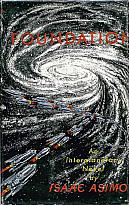 (Cover design by David Kyle)
(Cover design by David Kyle)SFDG -> Specific Books -> The Foundation Trilogy -> THE FOUNDATION TRILOGY: Notes, Articles, and Links -> The Stories that Make Up The Foundation Trilogy
Isaac Asimov's The Foundation Trilogy is most often printed in three volumes—Foundation, Foundation and Empire, and Second Foundation. Most people probably think of the Trilogy as a sequence of three novels. In my opinion, however, The Foundation Trilogy is best thought of as a collection of nine stories, especially since eight of the stories were written as stand-alone pieces for John W. Campbell's Astounding Science-Fiction magazine and first published there. Here is a list of the stories that make up The Foundation Trilogy, along with some notes.
 (Cover design by David Kyle)
(Cover design by David Kyle)
First Appearance: Foundation (Gnome Press, 1951)
Notes: Written per the request of the publisher of Gnome Press (possibly Martin Greenberg, who should not be confused with the modern anthologist Martin Harry Greenberg). This story appears in all book versions of Foundation.
This is the only one of the stories of The Foundation Trilogy that was written to be part of a book. As Asimov wrote in “The Story Behind the Foundation”:
The publisher of Gnome felt, however, that the series began too abruptly. He persuaded me to write a small Foundation story, one that would serve as an introductory section to the first book (so that the first part of the Foundation series was the last written).
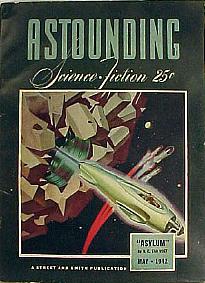 (Cover art
by Hubert Rogers)
(Cover art
by Hubert Rogers)
First Appearance: As the main part of the novelette “Foundation” in the May 1942 issue of Astounding Science-Fiction.
Collected In: Foundation
Notes: The novelette version of “Foundation” was originally the beginning of the series, and thus it opens with a scene depicting Hari Seldon at a secret meeting of his group. This scene does not appear in any book version of Foundation (since it was replaced by “The Psychohistorians”, story # 1 above).
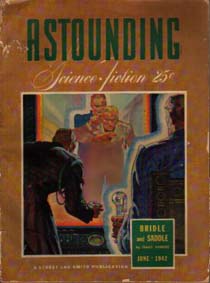 (Cover art
by Hubert Rogers)
(Cover art
by Hubert Rogers)
First Appearance: As the novelette “Bridle and Saddle”, which was the cover story of the June 1942 issue of Astounding Science-Fiction.
Collected In: Foundation
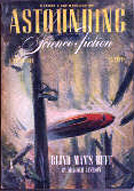 (Cover art
by William Timmins)
(Cover art
by William Timmins)
First Appearance: As the short story “The Wedge” on pages 64-79 of the October 1944 issue of Astounding Science-Fiction.
Collected In: Foundation
Notes: Although this appeared after the story of “The Merchant Princes”, it is printed before that story in the book version of Foundation.
In the original short story, the main character is named Lathan Devers! In the book version of Foundation, this was changed to “Limmar Ponyets”. Devers later appeared as a major character in “Dead Hand”, which was reprinted as “The General”, the first major section of Foundation and Empire (story #6 below).
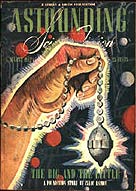 (Cover art by William Timmins)
(Cover art by William Timmins)
First Appearance: As the novelette “The Big and The Little”, which was the cover story of the August 1944 issue of Astounding Science-Fiction.
Collected In: Foundation
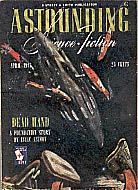 (Cover art
by William Timmins)
(Cover art
by William Timmins)
First Appearance: As the novelette “Dead Hand”, which was the cover story of the April 1945 issue of Astounding Science-Fiction.
Collected In: Foundation and Empire
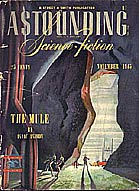 (Cover art
by William Timmins)
(Cover art
by William Timmins)
First Appearance: Serialized in the November 1945 (where it was the cover story) and December 1945 issues of Astounding Science-Fiction.
Collected In: Foundation and Empire
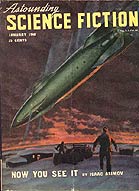 (Cover art
by Hubert Rogers)
(Cover art
by Hubert Rogers)
First Appearance: As the novella “Now You See It…”, which was the cover story of the January 1948 issue of Astounding Science-Fiction
Collected In: Second Foundation
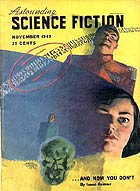 (Cover art
by Hubert Rogers)
(Cover art
by Hubert Rogers)
First Appearance: As the novella “…And Now You Don't”, serialized in the November 1949 (where it was the cover story), December 1949, and January 1950 issues of Astounding Science-Fiction
Collected In: Second Foundation
Most of the differences between the magazine and book versions of these Foundation stories are minor. The single biggest change is the replacement of the original opening of “Foundation” with “The Psychohistorians”, as noted above.
The next biggest change is recurrent: In the books, each Foundation story is preceded by an excerpt from the Encyclopedia Galactica (specificially, “the 116th edition published 1020 F.E.”). A few other Galactica excerpts also appear within the stories. But on their original magazine appearances, none of these stories included excerpts from the Encyclopedia Galactica. I presume that Asimov wrote these excerpts for the books.
(This leads to one interesting difference: The story “Search By The Mule” is preceded by an excerpt from the Encyclopedia Galactica and then the story proper starts by commenting directly on that excerpt [“There is much more that the Encyclopedia has to say …”]. If the Galactica excerpts first appeared in the books, how did the corresponding magazine story, “Now You See It …” originally start? The answer is that the magazine stories include occasional excerpts from various sources; in this particular case, the excerpt is from Essays on History by “Ligurn Vier”, which work is described as “formidable and definitive” in a footnote in “… And Now You Don't” [the magazine version of “Search By The Foundation”]).
The last class of changes is minor: When the stories were published in book form, punctuation marks, phrases, or perhaps a whole sentence might be modified, added, or subtracted. Most of these changes are probably of interest only to scholars or die-hards like me. The single biggest one that comes to mind: “Dead Hand” names Hari Seldon's planet of birth as Siwenna! Perhaps Asimov did this to explain why Ducem Barr knows so much about Seldon, and the Seldon Plan. In the book version, “The General”, this point is omitted and, indeed, the excerpt from the Galactica that opens the entire series in book form says Seldon was born “on Helicon, Arcturus sector”.
As time permits, I will try to post more information about these changes.